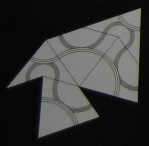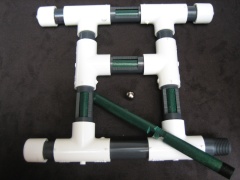Tromino Trails
In the summer of 2009, at the annual International Puzzle Party, we were treated to a talk by the justly renowned computer scientist, mathematician, and author (and all-around Really Nice Guy™) Donald Knuth. He spoke about some of his favorite puzzles and some new puzzle ideas he'd been working on. As part of the presentation, he passed out a sheet of paper with several puzzles on it for us to solve later.
One of the entries on the paper was a description of an interesting set of twelve trominoes (aka triominoes), pieces made up of three unit squares joined in a little 'L' shape. Each piece had a line drawn on it (on both sides, so you could flip the pieces over), and your goal was to arrange them into a six-by-six square such that all of the lines formed a single, unbroken loop The solution, he said, was unique. OK, fun enough, but Don wasn't through, not by a long shot.
Then, he listed four more similar trominoes and said that, if you added those new pieces to the original ones, you could arrange them all into an eight-by-six rectangle, with the lines again forming a single continuous loop, and again the solution was unique. This was sounding even better, but he kept going!
Next, Don showed two more trominoes to add in, now enabling you to build a unique nine-by-six rectangle with the same properties. That was followed by yet two more trominoes, now forming a unique ten-by-six rectangle!
Finally, he showed four more tominoes you could add to everything that had gone before, with the entire set now making a nine-by-eight rectangle, still with the lines forming a single continuous loop, and still with a unique solution!
Five separate, progressively more difficult challenges, all from the same set of simple-seeming pieces, all with unique solutions: this was great, an elegant puzzle construction! There was only one teensy-tiny little problem: Don hadn't actually given us the puzzle! All we had was a description of the puzzle, stuck on this sheet of paper!
I immediately resolved to design a nice physical packaging of Don's puzzle idea, with all five challenges and all twenty-four tromino pieces included, along with a simple way to remember which pieces went with each challenge. The result is Tromino Trails. The initial six-by-six challenge isn't trivial, but also isn't particularly difficult. After that, each challenge poses a progressively tougher problem but also trains you, in a sense, to be ready for the challenge that follows.
My friend Stan Isaacs used this as his Exchange puzzle at this summer's International Puzzle Party in Berlin, and now I can make it available more broadly. I think it provides a very satisfying puzzle experience that's accessible to and enjoyable by both experts and new puzzlers alike.


